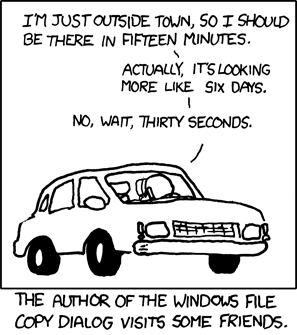The Exercise
All that is required is that you make three estimates for the same task under slightly different conditions. The task is to pick someone up from the airport; the estimate is how long it will take to get there. In all cases, the estimates should be made using the same parameters (time of day, route, place of origin, weather, etc.) with the only consideration being the person that you are picking up. In each case, write down or make a mental note of your estimate.
Case 1: Your neighbor is on a trip and he calls from a Midwest airport. His wife just called him to say she is leaving him, his truck broke down, and he now needs to find someone to pick him up at the airport. His life is drama, but you owe him a favor so you reluctantly agree to pick him up.
How much time do you allot to get to the airport to get him?
 |
|
Ask for more info above, or if you are convinced, just add it to your cart.. |
Look at the
|
Estimates Are Part of a Project System
One of the problems with estimates is that they are too short or too long; they never match the actual time. This, of course, is why they are called estimates! In theory, if you give a couple hundred estimates, roughly half of them are high and half of them are low. In the end, all the differences wash out and you are more or less on time. Herein lies the problem. Good estimates need to be looked at as a set, rather than individually. If each estimate is graded on its own merits without regard to the system they are in, then we are really treating them as quotes.
On to case two.
Case 2: Your boss is on a business trip and she calls from another Midwest airport. She just got a call from her husband and he broke a tooth, which has sent him to an emergency dentist's appointment. She wants to know if you will come get her at the airport. In the call, where she mentions the great results from the trip, she apologizes for your review being late and says that you can talk about it on the way back to the office in the car. You are excited to get the review since you have made some stellar accomplishments this last period. How much time do you allot to get to the airport to get her? You surely do not want to jeopardize your review.
Again, make a note of your estimate.
Estimates Are Not Quotes.
Unfortunately, managers often take estimates as quotes. They reprimand for people being a day late (for obvious reasons) and if the delivery is early, the expectation is that all tasks will be early since there was obvious pad. People have no choice but to pad their estimates heavily and to continue to perfect the deliverable until the delivery date is reached. The perfectly timed delivery averts the punitive response from management. Always on time, what could be better? Unfortunately, this develops a schedule that is severely longer than needed. Therefore, there is no sense of urgency, people start their tasks late, work on other tasks (thinking they have plenty of time) and eventually have difficulty making the deadline. Huge amounts of time and money are wasted.
Case 3: For the last condition, we need a little imagination. You answer the phone and, to your surprise, it is the Secret Service needing someone that no one would ever guess would have the US President in their car. They have chosen you. The President they are asking you to pick up is your favorite and you are honored and excited. The Secret Service wants you to be on time; after all, who leaves the President waiting on the curb outside baggage claim?
How much time do you allot to get to the airport to pick up the President?
Reflect on your three answers. For most people, the times are progressively longer and they usually attribute the increase in trip time to the consequences of being late; however, being late to pick up the President has no consequences—except your own lost pride. In all cases, the reasons for the variation are quite different. In the first case, the task is a chore, in the second there is the potential of a damaged review, in the third a sense of honor. Therefore, even within ourselves, we bias estimates based on the type of task and our feelings toward it. The factors affecting the estimates are subconscious.
What do you think?
Granted the cases are contrived, however you should be able to see how similar situations arise in everyday life. What do you see as the biggest issue in getting good estimates? Is it lack of task definition? Experience level? Optimism about fun tasks? Pessimism about factors effecting tasks? Maybe it is biasing estimates to meet a manager's expectations. Or, is it the organization's culture conditioning people to give estimates that meet their political needs.
.png)
 Twitter
Twitter Facebook
Facebook RSS
RSS Linkedin
Linkedin



.png)






.png)
